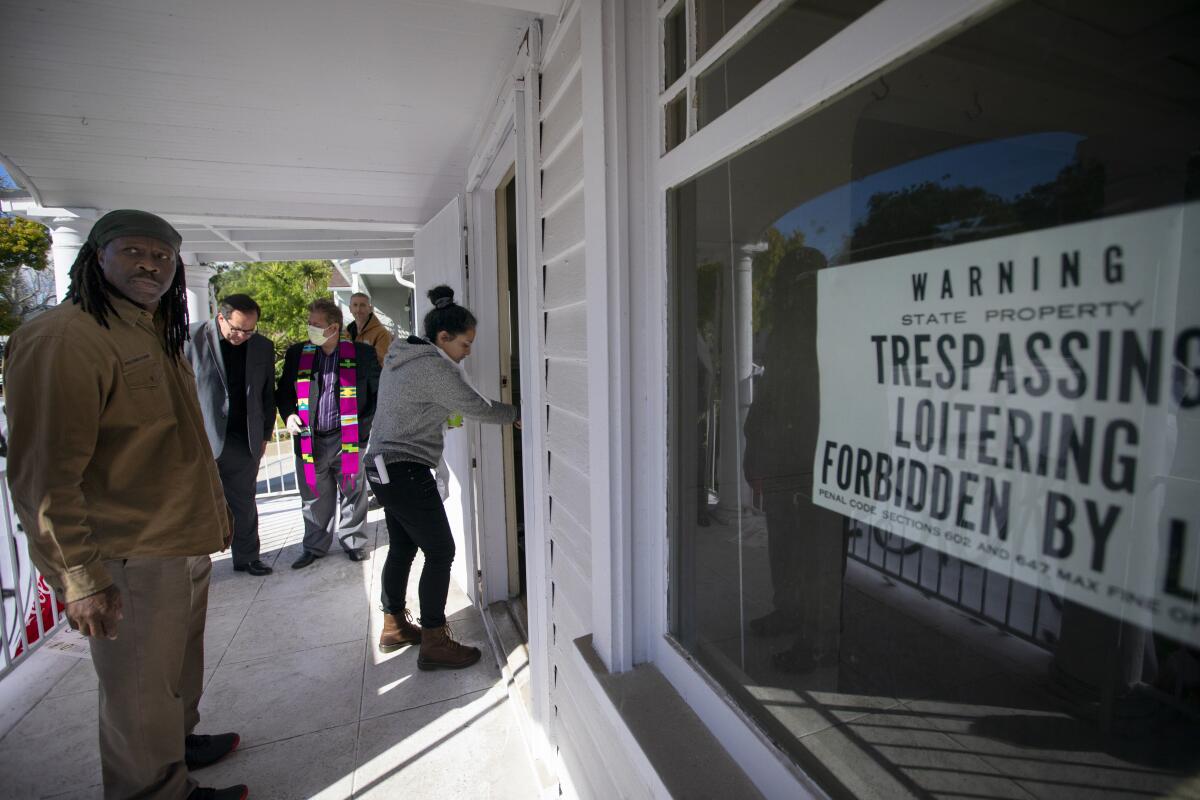It shouldn’t take squatters to compel California to act on homelessness

- Share via
How is it possible that more than seven months into the pandemic there are still publicly owned houses sitting empty while thousands of men, women and families are homeless? Yet that is exactly what is happening in El Sereno, where dozens of houses and apartments owned by Caltrans, the state transportation agency, remain vacant despite pleas to sell or rent the properties as affordable housing.
Last week activists calling themselves Reclaim and Rebuild Our Community commandeered nearly 20 houses and attempted to move homeless families and individuals into the properties. The California Highway Patrol ousted the squatters on the evening before Thanksgiving and arrested dozens of people for trespassing and burglary. The homeless families were offered hotel vouchers.
It was the second time this year that activists have sought to “reclaim” the vacant properties. In March, amid the first shelter-in-place order, another group, called Reclaiming Our Homes, took over a dozen of the Caltrans houses in an act of civil disobedience. They argued it was unconscionable to allow so many empty, decaying homes to sit idle during a public health emergency.
They’re right. It shouldn’t take protests and illegal squatters for state agencies to treat the pandemic housing crisis with the utmost urgency. The saga of the Caltrans homes is a long and frustrating example of why California — despite spending billions of dollars to end homelessness — is still struggling to get put needy families into stable housing, even where there is public land and property readily available. And it’s why activists sometimes resort to unorthodox and even illegal tactics to push governments agencies to act.
Caltrans acquired the properties decades ago and planned to demolish them to make way for the 710 Freeway extension. But the proposal to “close the gap” — by building the final 4.5-mile stretch to connect the 710 to the 210 Freeway — was finally killed by the Los Angeles County Metropolitan Transportation Authority in 2017. That left more than 400 properties, including houses, apartments, commercial buildings and vacant lots surplus. Some are occupied by tenants, but 87 single-family homes are vacant.
Caltrans had long been criticized for being an absentee landlord, with some properties boarded up and covered in graffiti. Neighbors and community groups repeatedly called on the agency to hurry up and sell the properties. But the process has been sluggish at best. The agency has sold 10 properties since 2016; nine were bought by tenants at below-market prices.
Caltrans has been tied up in regulatory hurdles and state laws that dictate how surplus property must be sold, and that has hindered the agency’s ability to move quickly to rent or sell dozens of vacant homes for affordable housing. A bill to clarify and speed up the process for the former 710-corridor properties was shelved last session — a victim of the Legislature’s failure to act on much-needed housing bills.
Yes, the attempts to “reclaim” the Caltrans houses are illegal. The activists are trespassing on state-owned land and essentially claiming public property as their own. The houses are not hooked up to utilities. Some properties haven’t been repaired in decades, or have pest infestations or other deficiencies that make them unsafe for habitation. Squatting is not a sustainable solution.
But the fact of the matter is that the protests in March worked. As a result of the public and political attention, Caltrans and the Housing Authority of the City of Los Angeles negotiated a unique deal. The state agreed to lease 22 properties to the housing authority for up to three years. The Housing Authority is using the properties as transitional housing for families, including some of the original reclaimers. Many of the other properties are too run-down to rent, but the two agencies will consider adding more homes to the lease agreement.
It’s heartening that the city and state have been able to make good use of these once-empty homes. With the state still deep in a homelessness crisis and a public health emergency, this kind of cooperation should be the rule, not the exception.
More to Read
A cure for the common opinion
Get thought-provoking perspectives with our weekly newsletter.
You may occasionally receive promotional content from the Los Angeles Times.









